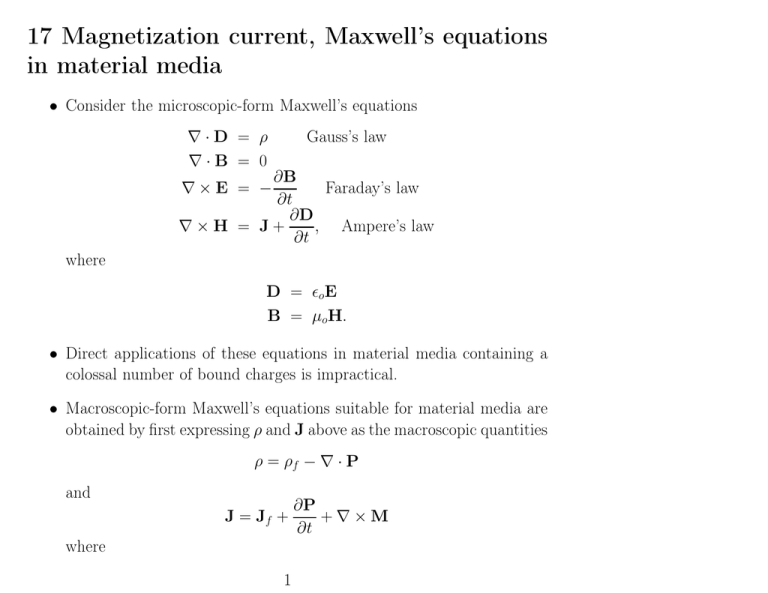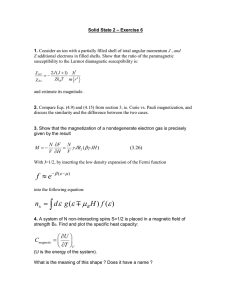17 Magnetization current, Maxwell`s equations in material media
advertisement

17 Magnetization current, Maxwell’s equations in material media • Consider the microscopic-form Maxwell’s equations Gauss’s law ∇·D = ρ ∇·B = 0 ∂B Faraday’s law ∂t ∂D ∇×H = J+ , Ampere’s law ∂t ∇×E = − where D = #o E B = µoH. • Direct applications of these equations in material media containing a colossal number of bound charges is impractical. • Macroscopic-form Maxwell’s equations suitable for material media are obtained by first expressing ρ and J above as the macroscopic quantities and ρ = ρf − ∇ · P J = Jf + where 1 ∂P +∇×M ∂t – subscripts f indicate charge and current density contributions due to free charge carriers, – the term −∇ · P denotes the bound charge density, – the term ∂P ∂t denotes the polarization current density due to oscillating dipoles (already discussed in Lecture 11), and – ∇×M is a “magnetization current density” also due to bound charges, an effect that we will discuss and clarify later in this section. Using these expressions in Gauss’s and Ampere’s laws Gauss’s law ∂#oE B = J + ∇ × µ−1 , Ampere’s law o ∂t ∇ · #o E = ρ we obtain Gauss’s law ∇ · (#oE + P) = ρf ∇ × (µ−1 o B − M) = Jf + ∂ (#oE + P), ∂t Now, re-define D and H as D = #eE + P = #E and −1 H = µ−1 o B − M = µ B, 2 Ampere’s law. respectively, and drop the subscripts f which will no longer be needed. Using these new definitions, the full set of Maxwell’s equations now read as (the same form as before) Gauss’s law ∇·D = ρ ∇·B = 0 ∂B Faraday’s law ∂t ∂D , Ampere’s law ∇×H = J+ ∂t ∇×E = − with D = #E B = µH, where ρ and J are understood to be due to free charge carriers only. • We had already seen many aspects of the above procedure for obtaining the macroscopic form field equations earlier on (e.g., in Lectures 8 and 11). – In particular we were already familiar with the revised definition of D = #E along with the concept of medium permittivity #. – The new feature above that requires further discussions is the relation B = µH along with the concept of medium permeability µ. The details of this relation are connected to the concept of “magnetization current” which we discuss next. 3 • Just like “free charge” density and currents, “bound charge” densities and currents also have to satisfy the continuity equation ∂ρ + ∇ · J = 0. ∂t – This equation is automatically satisfied if we substitute ρ = ρb = −∇ · P and J = Jb = in it. Verification: ∂P ∂t ∂P ∂ ∂ρb + ∇ · Jb = (−∇ · P) + ∇ · =0 ∂t ∂t ∂t since the order of time derivative and divergence can be exchanged on the right. – But the same equation is also satisfied if we take Jb = ∂P +∇×M ∂t for any vector field M simply because vector ∇ × M is divergence free. 4 Consequently, it is not sufficient to represent bound currents in material media as simply ∂P ∂t , if bound carriers can also conduct divergencefree currents due to closed-loop orbits. – In fact, electrons “orbiting” atomic nuclei certainly produce such divergence-free current loops at microscopic scales — we account for such currents at macroscopic scales by including a magnetization current term ∇ × M in Jb . – Also, bound charge motions within nucleons1 — proton and neutrons — produce magnetization currents ∇ × M. – Even bare electrons can produce magnetization currents ∇ × M because of their intrinsic spin 2. Once ∇ × M is included in Jb , it follows from Ampere’s law that H = µ−1 o B−M where M is referred to as magnetization field. 1 Physical models of nucleons involve bound charge carriers known as quarks which cannot be observed in a free state. 2 All elementary charge carriers carry an intrinsic magnetization proportional to charge-to-mass ratio q and a “spin angular momentum” having quantized values of ± !2 N.m.s in any measurement direction. m Using Heisenberg’s uncertainty principle, ∆p∆r ≥ !2 , we can interpret the spin angular momentum of an elementary particle as the lower bound of ∆p∆r, the product of quantum uncertainties in particle momentum and position. There is no classical interpretation of spin angular momentum for point particles. 5 • Lab measurements — e.g., inductances L measured for coils wound around magnetic materials (see below) — show that for a large class of materials M ≡ µ−1 o B−H varies linearly with H (which is of course possible only when B also varies linearly with H). – In that case we write M = χm H, where χm is a dimensionless parameter called magnetic susceptibility, and obtain a relation Magnetic susceptibility B = µo(1 + χm )H = µH, and permeability where µ = µo(1 + χm) is called the permeability of the medium. Recall from Lecture 15 that L ∝ µ when inductors are wound around materials with permeability µ. Hence, lab measurements of L can provide us with estimates of µ for various materials. • For a large class of materials with M ∝ H, it is observed that |χm| ' 1. In that case, the material is called 6 – Diamagnetic if χm < 0: ◦ Diamagnetism occurs when an applied magnetic field induces electron orbital angular momentum in a collection of atoms having no permanent magnetization M. These are materials that we ordinarily think of being non-magnetic (wood, glass, etc.). They are in fact very weakly repulsed by permanent magnets. – Paramagnetic if χm > 0: ◦ Paramagnetism occurs when an applied magnetic field coaligns the spin angular momentum of electrons in atoms having a permanent magnetization — intrinsic magnetic moments (and hence M) are then aligned to point in the applied B direction. This occurs for atoms with unfilled inner electron shells, because in filled shells electron spins are opposite (due to Pauli exclusion principle) and cancel one another. Unfilled outer shells do not usually give rise to paramagnetism because interactions between adjacent atoms in that case give rise to opposite spins of their outer shell electrons. Paramagnetic materials are are very weakly attracted to permanent magnets. • In a small class of materials known as ferromagnets — iron, nickel, and cobalt, which are metals with atoms having unfilled inner electron shells, and their various alloys — M can arise spontaneously (because permanent magnetic dipole moments of nearby atoms produced by elec7 tron spins become co-aligned as a consequence of conduction electrons moving through the lattice) and turns out to be a non-linear function of present and past values of H, in which case experimentally obtained relations, denoted as B = B(H), need to be used in Maxwell’s equations. It is even possible to have non-zero B in such materials with zero H — permanent magnets have that property. • First principles modeling of χm or B = B(H) relation requires quantum mechanics (classical models turn out to be not accurate enough). Overall, the models give rise to frequency dependent results, involving loss as well as resonance features (also exhibited in Lorentz-Drude models of χe examined in Lecture 11) relevant for applications including various magnetic imaging techniques. 8



